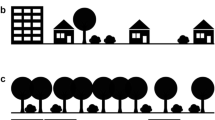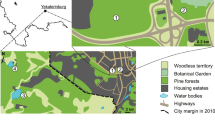Abstract
Green infrastructure in urbanized areas has a dual purpose that achieves both sociological and ecological goals. To benefit society and the urban ecosystem, green infrastructure should be effectively managed. We investigated carabid diversity and assemblage structure as indicators of biodiversity in green infrastructures in a rapidly developing urban area to identify the habitat’s values. In addition, we attempted to reveal the effect of environmental variables (e.g., vegetation structure, soil, and disturbance) that strongly contribute to carabid diversity and assemblage structure. Of the collected organisms, 6,154 individuals representing 20 carabid species were identified in the green infrastructure. Those species with flight ability and that were found in dry habitats were widely distributed and dominated green infrastructures. Carabid assemblages changed significantly in response to management practices. These changes were both positive and negative, with the negative changes increasing the instability of the carabid assemblages through the destruction of their habitat. Other factors, such as the presence of original habitat, habitat age, and habitat succession, also had a considerable effect on carabid diversity. We revealed that management practices prevented habitat succession, and these interactive effects determined carabid diversity and structure in green infrastructures.



Similar content being viewed by others
References
Angold P, Sadler JP, Hill MO, Pullin A, Rushton S, Austin K, Small E, Wood B, Wadsworth R, Sanderson R (2006) Biodiversity in urban habitat patches. Sci Total Environ 360:196–204
Blake S, Foster GN, Fisher GEJ, Ligertwood GL (1996) Effects of management practices on the carabid faunas of newly established wildflower meadows in southern Scotland. Ann Zool Fenn 33:139–147
Brose U (2003) Bottom-up control of carabid beetle communities in early successional wetlands: Mediated by vegetation structure or plant diversity? Oecologia 135:407–413
Brown JH (1984) On the relationship between abundance and distribution of species. Am Nat 142:255–279
Colding J, Lundberg J, Folke C (2006) Incorporating green-area user groups in urban ecosystem management. Ambio 35:237–244
Daily GC, Polasky S, Goldstein J, Kareiva PM, Mooney HA, Pejchar L, Ricketts TH, Salzman J, Shallenberger R (2009) Ecosystem services in decision making: Time to deliver. Front Ecol Environ 7:21–28
Dearborn DC, Kark S (2009) Motivations for conserving urban biodiversity. Conserv Biol 24:432–440
Do Y, Jeong KS, Lineman M, Kim JY, Kim HA, Joo GJ (2011) Community changes in carabid beetles (Coleoptera: Carabidae) through ecological succession in abandoned paddy fields. J Ecol Field Biol 34:269–278
Do Y, Lineman M, Joo GJ (2012a) Effects of agricultural abandonment on carabid beetles in paddy fields. Baltic J Coleopterol 12:65–76
Do Y, Lineman M, Joo GJ (2012b) Impacts of different land-use patterns on the carabid beetle diversity and species assemblages in South Korea. Ekoloji 21:9–17
ElSayed WM, Nakamura K (2010) Abundance, diversity and distribution of the ground beetles (Coleoptera: Carabidae) in a satoyama valley in Kanazawa, Japan, with special reference to the body size and feeding categories. Far Eastern Entomol 205:1–19
Eversham BC, Roy DB, Telfer MG (1996) Urban, industrial and other manmade sites as analogues of natural habitats for Carabidae. Ann Zool Fenn 33:149–156
Eyre M, Luff M, Woodward J (2003) Beetles (Coleoptera) on Brownfield sites in England: An important conservation resource? J Insect Conserv 7:223–231
Fattorini S (2011) Insect extinction by urbanization: A long term study in Rome. Biol Conserv 144:370–375
Fattorini S (2013) Species ecological preferences predict extinction risk in urban tenebrionid beetle guilds. Anim Biol 63:93–106
Foster D, Swanson F, Aber J, Burke I, Brokaw N, Tilman D, Knapp A (2003) The importance of land-use legacies to ecology and conservation. Bioscience 53:77–88
Gilbert OL (1989) The ecology of urban habitats. Chapman and Hall, London
Gill D, Bonnett P (1973) Nature in the urban landscape: A study of city ecosystems. York Press, Baltimore
Gill S, Handley J, Ennos A, Pauleit S (2007) Adapting cities for climate change: The role of the green infrastructure. Built Environ 33:115–133
Goddard M, Dougill A, Benton T (2010) Scaling up from gardens: biodiversity conservation in urban environments. Trends Ecol Evol 25:90–98
Hammer Ø, Harper D, Ryan P (2001) PAST: Paleontological statistics software package for education and data analysis. Palaeontol Electron 4:1–9
Hartley DJ, Koivula MJ, Spence JR, Pelletier R, Ball GE (2007) Effects of urbanization on ground beetle assemblages (Coleoptera, Carabidae) of grassland habitats in western Canada. Ecography 30:673–684
Herkert JR (1994) The effects of habitat fragmentation on Midwestern grassland bird communities. Ecol Appl 4:461–471
Jim C (2004) Green-space preservation and allocation for sustainable greening of compact cities. Cities 21:311–320
Kindt R, Coe R (2005) Tree diversity analysis. A manual and software for common statistical methods for ecological and biodiversity studies. World Agroforestry Centre (ICRAF), Nairobi
Koivula MJ (2011) Useful model organisms, indicators, or both? Ground beetles (Coleoptera, Carabidae) reflecting environmental conditions. Zookey 100:287–317
Koivula MJ, Vermeulen HJW (2005) Highways and forest fragmentation—Effects on carabid beetles (Coleoptera, Carabidae). Landsc Ecol 20:911–926
Legendre P, Legendre L (1998) Numerical ecology. Second edition. Developments in environmental modelling. Elsevier, Amsterdam
Luff M, Eyre M, Rushton S (1992) Classification and prediction of grassland habitats using ground beetles (Coleoptera, Carabidae). J Environ Manag 35:301–315
MacArthur R (1960) On the relative abundance of species. Am Nat 94:25–36
Magurran AE (1988) Ecological diversity and its measurement. Princeton University Press, Princeton
Magurran AE (2004) Measuring biological diversity. Blackwell Science, Malden
McCune B, Grace JB, Urban DL (2002) Analysis of ecological communities. MjM Software Design, Gleneden Beach
McIntyre NE (2000) Ecology of urban arthropods: A review and a call to action. Ann Entomol Soc Am 93:825–835
McKinney ML (2008) Effects of urbanization on species richness: A review of plants and animals. Urban Ecosyst 11:161–176
Mortimer SR, Booth RG, Harris SJ, Brown VK (2002) Effects of initial site management on the Coleoptera assemblages colonising newly established chalk grassland on ex-arable land. Biol Conserv 104:301–313
Niemelä J, Kotze DJ (2009) Carabid beetle assemblages along urban to rural gradients: A review. Landsc Urban Plann 92:65–71
Niemelä J, Kotze DJ, Venn S, Penev L, Stoyanov I, Spence J, Hartley D, De Oca EM (2002) Carabid beetle assemblages (Coleoptera, Carabidae) across urban–rural gradients: An international comparison. Landsc Ecol 17:387–401
Pavao-Zuckerman MA (2008) The nature of urban soils and their role in ecological restoration in cities. Restor Ecol 16:642–649
Pickett STA, Cadenasso M, Grove J, Nilon C, Pouyat R, Zipperer W, Costanza R (2008) Urban ecological systems: Linking terrestrial ecological, physical, and socioeconomic components of metropolitan areas. Annu Rev Ecol Syst 32:99–122
Pinna S, Varady-Szabo H, Boivin P, Lucas E (2009) Relevance of using a vegetation-based method to conserve urban carabid diversity. J Insect Conserv 13:387–397
Prach K, Walker LR (2011) Four opportunities for studies of ecological succession. Trends Ecol Evol 26:119–123
Raino J, Niemelä J (2003) Ground beetles (Coleoptera: Carabidae) as bioindicators. Biodivers Conserv 12:487–506
Ramalho CE, Hobbs RJ (2012) Time for a change: Dynamic urban ecology. Trends Ecol Evol 27:179–188
Ribera I, Dolédec S, Downie IS, Foster GN (2001) Effect of land disturbance and stress on species traits of ground beetle assemblages. Ecology 82:1112–1129
R Development Core Team (2008) R: A language and environment for statistical computing. Retrieved January 1, 2013 from http://www.R-project.org
Savard JPL, Clergeau P, Mennechez G (2000) Biodiversity concepts and urban ecosystems. Landsc Urban Plann 48:131–142
Seastedt TR, Hobbs RJ, Suding KN (2008) Management of novel ecosystems: Are novel approaches required? Front Ecol Environ 6:547–553
Shannon CE, Weaver W (1963) The mathematical theory of communication. University of Illinois Press, Urbana
Simpson EH (1949) Measurement of diversity. Nature 163:688
Small EC, Sadler JP, Telfer MG (2002) Carabid beetle assemblages on urban derelict sites in Birmingham, UK. J Insect Conserv 6:233–246
Soga M, Kanno N, Yamaura Y, Koike S (2013) Patch size determines the strength of edge effects on carabid beetle assemblages in urban remnant forests. J Insect Conserv 17:421–428
Strauss B, Biedermann R (2006) Urban brownfields as temporary habitats: driving forces for the diversity of phytophagous insects. Ecography 29:928–940
Taboada A, Kotze DJ, Tárregac R, Salgado JM (2006) Traditional forest management: Do carabid beetles respond to human-created vegetation structures in an oak mosaic landscape? For Ecol Manag 237:436–449
Thiele HU (1977) Carabid beetles in their environments. A study on habitat selection by adaptation in physiology and behaviour. Springer, Berlin
Tietze F (1987) Changes in the structure of carabid beetle Taxocoenoses in grassland affected by intensified management and industrial air pollution. Acta Phytopathol Entomol Hung 22:305–319
Topp W, Thelen K, Kappes H (2010) Soil dumping techniques and afforestation drive ground-dwelling beetle assemblages in a 25-year-old open-cast mining reclamation area. Ecol Eng 36:751–756
Tzoulas K, Korpela K, Venn S, Yli-Pelkonen V, Kaźmierczak A, Niemela J, James P (2007) Promoting ecosystem and human health in urban areas using green infrastructure: A literature review. Landsc Urban Plann 81:167–178
Ugland KI, Gray JS (1982) Lognormal distributions and the concept of community, equilibrium. Oikos 39:171–178
Varet M, Pétillon J, Burel F (2011) Comparative responses of spider and carabid beetle assemblages along an urban–rural boundary gradient. J Arachnol 39:236–243
Whittaker R (1965) Dominance and diversity in land plant communities: numerical relations of species express the importance of competition in community function and evolution. Science 147:250–260
Wilson JB (2009) Methods for fitting dominance/diversity curves. J Veg Sci 2:35–46
Working Group for Biological Indicator Ground Beetles Database, Japan (2011) Natural woodlands ground beetles. Retrieved January 1, 2013 from http://www.lbm.go.jp/emuseum/zukan/gomimushi/english/index.html
Wu JJ (2008) Making the case for landscape ecology an effective approach to urban sustainability. Landsc J 27:41–50
Author information
Authors and Affiliations
Corresponding author
Rights and permissions
About this article
Cite this article
Do, Y., Lineman, M. & Joo, GJ. Carabid beetles in green infrastructures: the importance of management practices for improving the biodiversity in a metropolitan city. Urban Ecosyst 17, 661–673 (2014). https://doi.org/10.1007/s11252-014-0348-1
Published:
Issue Date:
DOI: https://doi.org/10.1007/s11252-014-0348-1




